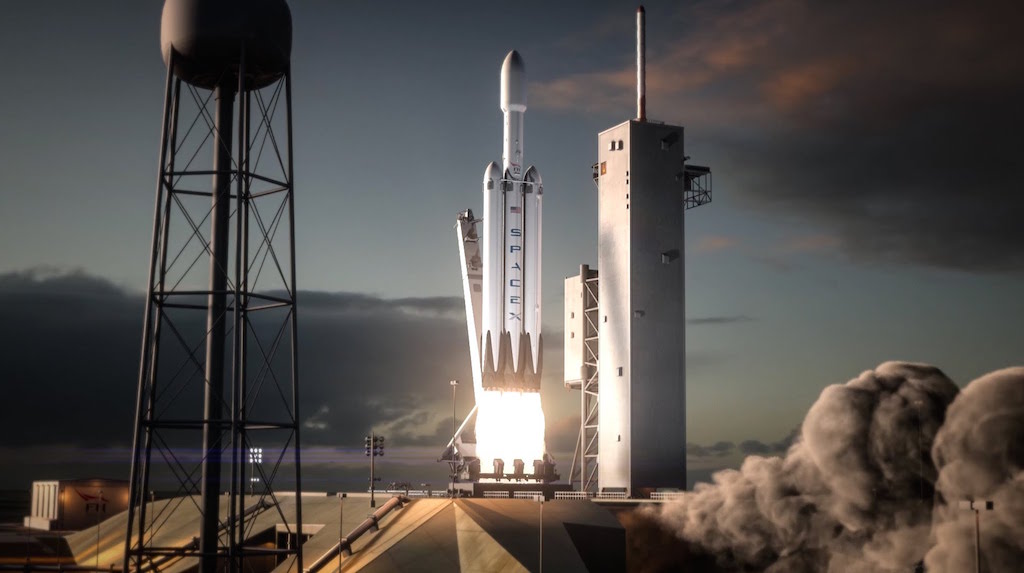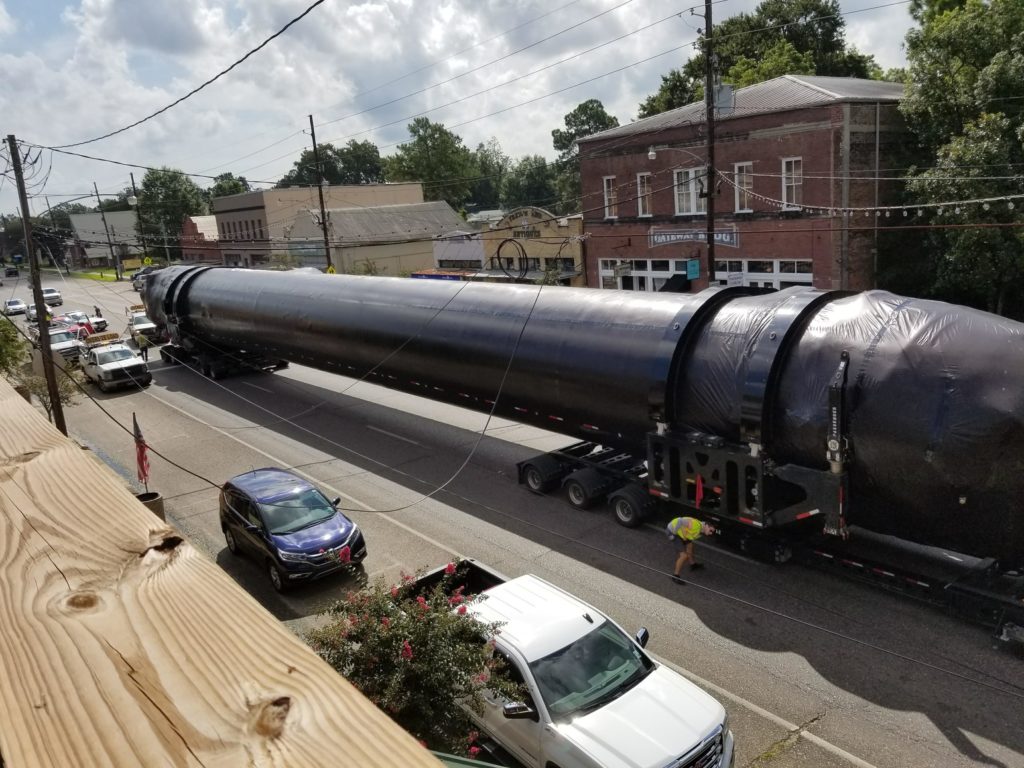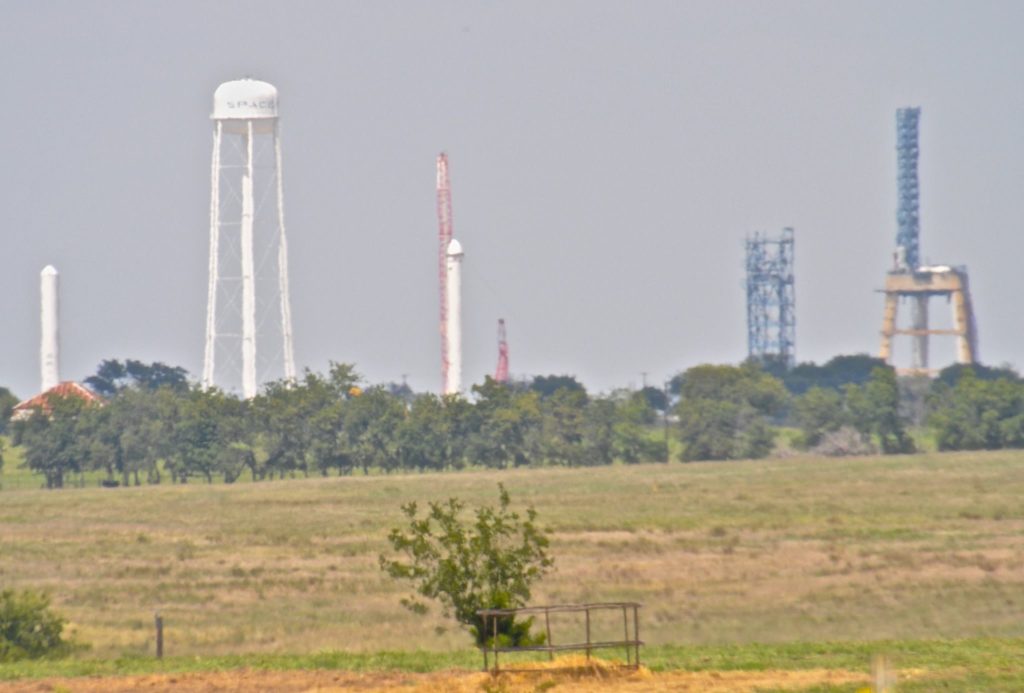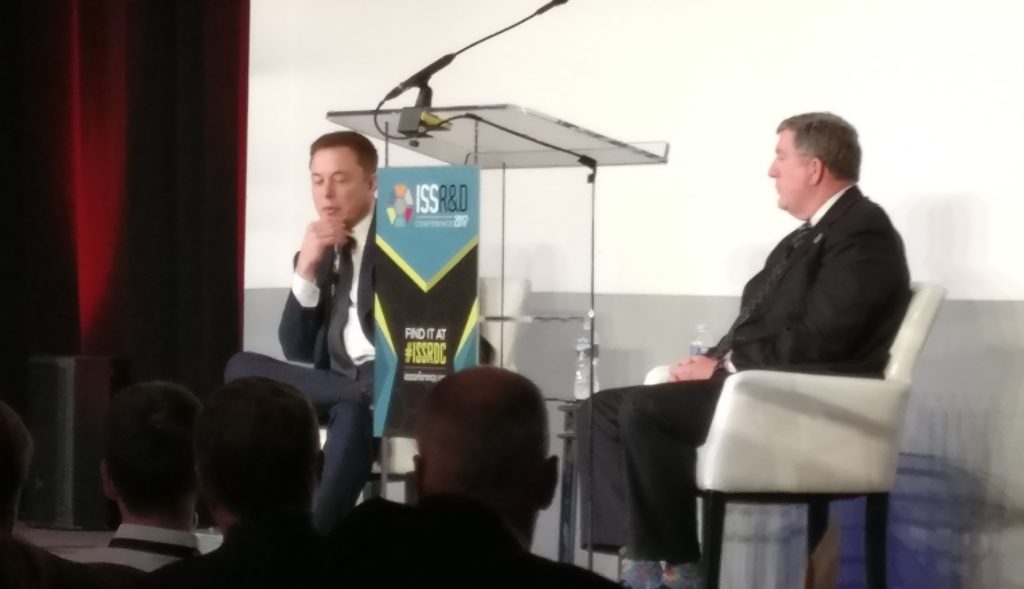

News
SpaceX’s Falcon Heavy tests continue in Texas, possible launch date revealed
After being tracked from Florida to Texas, a local observer near SpaceX’s McGregor, TX facilities spotted Falcon Heavy’s second side booster vertical on one of the area’s static fire test stands.
Posted to Facebook’s SpaceX group by Keith Wallace, a photo clearly shows the core’s distinctive nose cone, which takes the place of the interstage and improves the aerodynamic profile of the side boosters. The booster now on the stand in Texas is believed to be Core 1025, previously flown during the CRS-9 mission. The core has been modified significantly for its new role as a Falcon Heavy booster, largely in the form of strengthening structures, as well as the addition of the iconic nose cone and a connection interface that will allow it to attach to the center core.
- Falcon Heavy’s refurbished side core, spotted 8/21/17 in Louisiana by an observant fan. (reddit /u/neauxgeaux)
- Core 1025 spotted at SpaceX’s McGregor, TX facilities. (Facebook/Keith Wallace)
The other side booster, Core 1023, previously launched the Thaicom-8 geostationary communications satellite in 2016 and has since been refurbished, modified, and conducted two full duration static fires at the same facilities as 1025. The center core of Falcon Heavy was manufactured as a new vehicle in SpaceX’s Hawthorne, CA factory due to wide-ranging differences between its structure and the average Falcon 9 first stage.
Elon Musk made headlines when he put a significant damper on expectations for the Falcon Heavy’s inaugural launch, directly stating that he would deem the launch a success if it failed without destroying the launch pad. However, SpaceX President Gwynne Shotwell and Hans Koenigsmann, Vice President of Mission Assurance, both have made statements in the months since the conference indicating that SpaceX has considerably more confidence in the vehicle than Musk’s statements might suggest.
Coincidentally, a day before side booster #2 was spotted in Texas, a member of the Facebook group toured Kennedy Space Center Visitor Complex and noticed a launch calendar that suggested an inaugural launch date of November 28, 2017 for Falcon Heavy. The Visitor Complex is not run by NASA, so this date ought to be taken with many, many grains of salt. Regardless, with the final side booster now actively undergoing static fire testing ahead of being shipped back to Florida, Falcon Heavy is closer than it has ever been to being truly ready for launch. Several other big tasks lie ahead of SpaceX in order to prepare for the inaugural launch, mainly involving the reactivation of the launch pad LC-40 and subsequent modifications to LC-39A. Time will tell if the 28th of November is to become a historic day for the company.
Meanwhile, SpaceX continues to tackle its launch manifest at a seemingly routine pace of one launch every 14 or so days. Ahead of a launch currently scheduled for next Thursday, September 7, SpaceX has conducted static fire of the Falcon 9 first stage, this time the company’s East Coast launch pad, LC-39A. If all goes well, SpaceX will have the honor of sending a reusable spaceplane into orbit aboard its partially reusable Falcon 9, making for a truly appropriate pairing of payload and launch vehicle.
Static fire test complete—targeting Falcon 9 launch of OTV-5 from Pad 39A at @NASAKennedy on Thursday, September 7.
— SpaceX (@SpaceX) August 31, 2017

Elon Musk
Elon Musk and Tesla AI Director share insights after empty driver seat Robotaxi rides
The executives’ unoccupied tests hint at the rapid progress of Tesla’s unsupervised Robotaxi efforts.

Tesla CEO Elon Musk and AI Director Ashok Elluswamy celebrated Christmas Eve by sharing personal experiences with Robotaxi vehicles that had no safety monitor or occupant in the driver’s seat. Musk described the system’s “perfect driving” around Austin, while Elluswamy posted video from the back seat, calling it “an amazing experience.”
The executives’ unoccupied tests hint at the rapid progress of Tesla’s unsupervised Robotaxi efforts.
Elon and Ashok’s firsthand Robotaxi insights
Prior to Musk and the Tesla AI Director’s posts, sightings of unmanned Teslas navigating public roads were widely shared on social media. One such vehicle was spotted in Austin, Texas, which Elon Musk acknowleged by stating that “Testing is underway with no occupants in the car.”
Based on his Christmas Eve post, Musk seemed to have tested an unmanned Tesla himself. “A Tesla with no safety monitor in the car and me sitting in the passenger seat took me all around Austin on Sunday with perfect driving,” Musk wrote in his post.
Elluswamy responded with a 2-minute video showing himself in the rear of an unmanned Tesla. The video featured the vehicle’s empty front seats, as well as its smooth handling through real-world traffic. He captioned his video with the words, “It’s an amazing experience!”
Towards Unsupervised operations
During an xAI Hackathon earlier this month, Elon Musk mentioned that Tesla owed be removing Safety Monitors from its Robotaxis in Austin in just three weeks. “Unsupervised is pretty much solved at this point. So there will be Tesla Robotaxis operating in Austin with no one in them. Not even anyone in the passenger seat in about three weeks,” he said. Musk echoed similar estimates at the 2025 Annual Shareholder Meeting and the Q3 2025 earnings call.
Considering the insights that were posted Musk and Elluswamy, it does appear that Tesla is working hard towards operating its Robotaxis with no safety monitors. This is quite impressive considering that the service was launched just earlier this year.
Elon Musk
Starlink passes 9 million active customers just weeks after hitting 8 million
The milestone highlights the accelerating growth of Starlink, which has now been adding over 20,000 new users per day.

SpaceX’s Starlink satellite internet service has continued its rapid global expansion, surpassing 9 million active customers just weeks after crossing the 8 million mark.
The milestone highlights the accelerating growth of Starlink, which has now been adding over 20,000 new users per day.
9 million customers
In a post on X, SpaceX stated that Starlink now serves over 9 million active users across 155 countries, territories, and markets. The company reached 8 million customers in early November, meaning it added roughly 1 million subscribers in under seven weeks, or about 21,275 new users on average per day.
“Starlink is connecting more than 9M active customers with high-speed internet across 155 countries, territories, and many other markets,” Starlink wrote in a post on its official X account. SpaceX President Gwynne Shotwell also celebrated the milestone on X. “A huge thank you to all of our customers and congrats to the Starlink team for such an incredible product,” she wrote.
That growth rate reflects both rising demand for broadband in underserved regions and Starlink’s expanding satellite constellation, which now includes more than 9,000 low-Earth-orbit satellites designed to deliver high-speed, low-latency internet worldwide.
Starlink’s momentum
Starlink’s momentum has been building up. SpaceX reported 4.6 million Starlink customers in December 2024, followed by 7 million by August 2025, and 8 million customers in November. Independent data also suggests Starlink usage is rising sharply, with Cloudflare reporting that global web traffic from Starlink users more than doubled in 2025, as noted in an Insider report.
Starlink’s momentum is increasingly tied to SpaceX’s broader financial outlook. Elon Musk has said the satellite network is “by far” the company’s largest revenue driver, and reports suggest SpaceX may be positioning itself for an initial public offering as soon as next year, with valuations estimated as high as $1.5 trillion. Musk has also suggested in the past that Starlink could have its own IPO in the future.
News
NVIDIA Director of Robotics: Tesla FSD v14 is the first AI to pass the “Physical Turing Test”
After testing FSD v14, Fan stated that his experience with FSD felt magical at first, but it soon started to feel like a routine.

NVIDIA Director of Robotics Jim Fan has praised Tesla’s Full Self-Driving (Supervised) v14 as the first AI to pass what he described as a “Physical Turing Test.”
After testing FSD v14, Fan stated that his experience with FSD felt magical at first, but it soon started to feel like a routine. And just like smartphones today, removing it now would “actively hurt.”
Jim Fan’s hands-on FSD v14 impressions
Fan, a leading researcher in embodied AI who is currently solving Physical AI at NVIDIA and spearheading the company’s Project GR00T initiative, noted that he actually was late to the Tesla game. He was, however, one of the first to try out FSD v14.
“I was very late to own a Tesla but among the earliest to try out FSD v14. It’s perhaps the first time I experience an AI that passes the Physical Turing Test: after a long day at work, you press a button, lay back, and couldn’t tell if a neural net or a human drove you home,” Fan wrote in a post on X.
Fan added: “Despite knowing exactly how robot learning works, I still find it magical watching the steering wheel turn by itself. First it feels surreal, next it becomes routine. Then, like the smartphone, taking it away actively hurts. This is how humanity gets rewired and glued to god-like technologies.”
The Physical Turing Test
The original Turing Test was conceived by Alan Turing in 1950, and it was aimed at determining if a machine could exhibit behavior that is equivalent to or indistinguishable from a human. By focusing on text-based conversations, the original Turing Test set a high bar for natural language processing and machine learning.
This test has been passed by today’s large language models. However, the capability to converse in a humanlike manner is a completely different challenge from performing real-world problem-solving or physical interactions. Thus, Fan introduced the Physical Turing Test, which challenges AI systems to demonstrate intelligence through physical actions.
Based on Fan’s comments, Tesla has demonstrated these intelligent physical actions with FSD v14. Elon Musk agreed with the NVIDIA executive, stating in a post on X that with FSD v14, “you can sense the sentience maturing.” Musk also praised Tesla AI, calling it the best “real-world AI” today.











